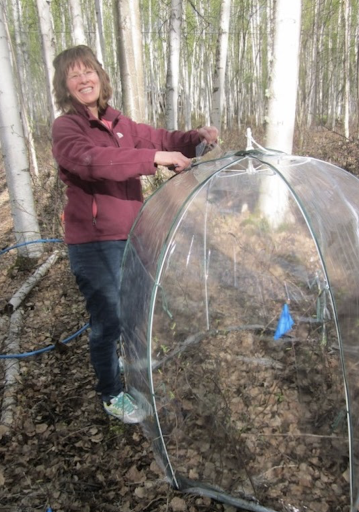Late Bloomers
A Far North Phenology Network Citizen Science Project
Have you ever seen wild rose or cranberry species flowering late in the fall, and you think, "man, little flower, why are you doing that? Don't you know the snow is coming??" Many woody plants in the boreal forest and arctic tundra pre-form their buds for the next year, and we think that these late blooming flowers might be a key to unlocking a strange mystery in the relationship between a changing climate and plant phenology.
A mystery in the fingerprint of global warming
For plants, the timing of flowering is a critical part of their life cycle. If plants flower too early or too late, they could miss the timing of their important pollinators or when animals like migrating birds come through and disperse their fruit.
Many flowering plants bloom earlier in response to warmer temperatures, and earlier flowering times of plants is often considered a fingerprint of global warming. Some species, however, either do not respond or delay flowering when there are warmer temperatures.
What explains these exceptions? It could be due: 1) plants could be responding to other cues like day length or soil moisture that may oppose the effects of warming, 2) increased snowfall that may result in delayed snow melt, or 3) warmer winter temperatures could result in unmet chilling requirements that delay when a plant emerges from dormancy.
We think that another reason may help explain why some species seem to break the rule: the timing of bud formation and its interaction with warmer temperatures and longer growing seasons. Shrubs, trees, and berry plants in northern latitudes start to develop their flower buds one or two years before they are needed. In a year with a longer than usual growing season, a first set of buds may open in spring, and then a second set of buds, intended for the next year, may open late in late summer or fall (a “late bloomer,” as we are calling it). The following spring, even if the timing of spring is early, these plants could take longer to flower as they wait to develop their next cohort of flower buds. Our research, funded by NSF, is testing this idea.
Research Goal
Evaluate whether anomalous phenological responses to warming temperatures (delayed or no apparent change in date of flowering) are explained, in part, by disruptions of flower development.
Approach
1. Open Top Chamber Experiment
We are using open top chambers in the BNZ LTER sites near the University of Alaska Fairbanks to experimentally warm woody boreal forest species for one or two years, leaving some plots as controls. We are looking at the development of leaf and flower primordia (the leaves or flowers forming in the buds) in the year following warming and two years after warming.

2. Citizen Science
Join scientists from University of Alaska Fairbanks and University of Connecticut in this research by making observations of late bloomers. In 2018 and 2019, volunteers and school groups from throughout Alaska See the Late Bloomers website for details!
Using overwintering Vaccinium vitis-idaea buds collected by volunteers from a wide range of locations will allow us to determine whether our experimental results are representative of those from a much larger area.
Observations of late-flowering plants of any of our focal species, recorded through our project on the Local Environmental Observers (LEO) Network, a program of the Alaska Native Tribal Health Consortium, will allow us to determine if there are any geographic or climatic patterns in late blooming plant observations.
Contacts:
Dr. Katie Spellman: katie.spellman@alaska.edu
Dr. Christa Mulder: cpmulder@alaska.edu
 B
B

